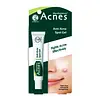What's inside
What's inside
 Key Ingredients
Key Ingredients

 Benefits
Benefits

 Concerns
Concerns

 Ingredients Side-by-side
Ingredients Side-by-side

Water
Skin ConditioningPropylene Glycol
HumectantCetyl Alcohol
EmollientHydrolyzed Rice Extract
Skin ConditioningPPG-14 Butyl Ether
Skin ConditioningCyclomethicone
EmollientTocopheryl Acetate
AntioxidantPaeonia Albiflora Root Extract
Skin ConditioningSalicylic Acid
MaskingDipotassium Glycyrrhizate
HumectantCamellia Oleifera Leaf Extract
AstringentPanthenol
Skin ConditioningBisabolol
MaskingAllantoin
Skin ConditioningCyclopentasiloxane
EmollientCyclohexasiloxane
EmollientDimethiconol
EmollientPEG-40 Stearate
EmulsifyingPvm/Ma Decadiene Crosspolymer
Polyacrylamide
C13-14 Isoparaffin
EmollientLaureth-7
EmulsifyingDisodium EDTA
Sodium Hydroxide
BufferingCaprylyl Glycol
EmollientCaprylic/Capric Triglyceride
MaskingEthylhexylglycerin
Skin ConditioningPhenoxyethanol
PreservativeWater, Propylene Glycol, Cetyl Alcohol, Hydrolyzed Rice Extract, PPG-14 Butyl Ether, Cyclomethicone, Tocopheryl Acetate, Paeonia Albiflora Root Extract, Salicylic Acid, Dipotassium Glycyrrhizate, Camellia Oleifera Leaf Extract, Panthenol, Bisabolol, Allantoin, Cyclopentasiloxane, Cyclohexasiloxane, Dimethiconol, PEG-40 Stearate, Pvm/Ma Decadiene Crosspolymer, Polyacrylamide, C13-14 Isoparaffin, Laureth-7, Disodium EDTA, Sodium Hydroxide, Caprylyl Glycol, Caprylic/Capric Triglyceride, Ethylhexylglycerin, Phenoxyethanol
Water
Skin ConditioningAlcohol
AntimicrobialButylene Glycol
HumectantGlycerin
HumectantSulfur
AntiseborrhoeicPEG-60 Hydrogenated Castor Oil
EmulsifyingTriethanolamine
BufferingCarbomer
Emulsion StabilisingHydroxypropyl Methylcellulose
Emulsion StabilisingTocopheryl Acetate
AntioxidantSalicylic Acid
MaskingCentella Asiatica Extract
CleansingAmylopectin
Dextrin
AbsorbentXanthan Gum
EmulsifyingDisodium EDTA
Stearyl Glycyrrhetinate
Skin ConditioningPropylene Glycol Alginate
O-Cymen-5-Ol
AntimicrobialBHT
AntioxidantPyridoxine Hcl
Skin ConditioningPropylparaben
PreservativeMethylparaben
PreservativeParfum
MaskingPolyquaternium-51
Skin ConditioningButyl Avocadate
Skin ConditioningChondrus Crispus Extract
Skin ConditioningPhenoxyethanol
PreservativeCinchona Succirubra Bark Extract
Skin ConditioningAsiaticoside
AntioxidantPropylene Glycol
HumectantMadecassic Acid
Skin ConditioningAsiatic Acid
Skin ConditioningChlorphenesin
AntimicrobialSodium Dehydroacetate
PreservativeCitric Acid
BufferingWater, Alcohol, Butylene Glycol, Glycerin, Sulfur, PEG-60 Hydrogenated Castor Oil, Triethanolamine, Carbomer, Hydroxypropyl Methylcellulose, Tocopheryl Acetate, Salicylic Acid, Centella Asiatica Extract, Amylopectin, Dextrin, Xanthan Gum, Disodium EDTA, Stearyl Glycyrrhetinate, Propylene Glycol Alginate, O-Cymen-5-Ol, BHT, Pyridoxine Hcl, Propylparaben, Methylparaben, Parfum, Polyquaternium-51, Butyl Avocadate, Chondrus Crispus Extract, Phenoxyethanol, Cinchona Succirubra Bark Extract, Asiaticoside, Propylene Glycol, Madecassic Acid, Asiatic Acid, Chlorphenesin, Sodium Dehydroacetate, Citric Acid
Ingredients Explained
These ingredients are found in both products.
Ingredients higher up in an ingredient list are typically present in a larger amount.
Disodium EDTA plays a role in making products more stable by aiding other preservatives.
It is a chelating agent, meaning it neutralizes metal ions that may be found in a product.
Disodium EDTA is a salt of edetic acid and is found to be safe in cosmetic ingredients.
Learn more about Disodium EDTAPhenoxyethanol is a preservative that has germicide, antimicrobial, and aromatic properties. Studies show that phenoxyethanol can prevent microbial growth. By itself, it has a scent that is similar to that of a rose.
It's often used in formulations along with Caprylyl Glycol to preserve the shelf life of products.
Propylene Glycol is an odorless, colorless liquid. As a humectant, it helps skin retain moisture. It also aids in delivering active ingredients.
Another role of this ingredient is preventing a product from melting or freezing. Propylene glycol also adds antimicrobrial properties to a product, elongating product lifespan.
This ingredient is considered an organic alcohol and commonly added into both cosmetics and foods.
Those with sensitive skin or conditions may develop a rash when using this ingredient.
Learn more about Propylene GlycolSalicylic Acid (also known as beta hydroxy acid or BHA) is a well-known ingredient for treating skin that struggles with acne and clogged pores. It exfoliates both the skin's surface and deep within the pores to help clear out buildup, control oil, and reduce inflammation.
Unlike AHAs (alpha hydroxy acids), salicylic acid is oil-soluble. This allows it to penetrate into pores which makes it especially effective for treating blackheads and preventing future breakouts.
Salicylic acid is also known for its soothing properties. It has a similar structure to aspirin and can calm inflamed or irritated skin, making it a good option for acne-prone skin that is also sensitive.
Concentrations of 0.5-2% are recognized by the U.S. FDA as an over-the-counter topical acne product.
It can cause irritation and/or dryness if one's skin already has a compromised moisture barrier, so it's best to focus on repairing that before introducing this ingredient into your routine.
While salicylic acid does not increase sun sensitivity, it’s still important to wear sunscreen daily to protect your skin.
If you are looking for the ingredient called BHA or Butylated Hydroxyanisole, click here.
Learn more about Salicylic AcidTocopheryl Acetate is AKA Vitamin E. It is an antioxidant and protects your skin from free radicals. Free radicals damage the skin by breaking down collagen.
One study found using Tocopheryl Acetate with Vitamin C decreased the number of sunburned cells.
Tocopheryl Acetate is commonly found in both skincare and dietary supplements.
Learn more about Tocopheryl AcetateWater. It's the most common cosmetic ingredient of all. You'll usually see it at the top of ingredient lists, meaning that it makes up the largest part of the product.
So why is it so popular? Water most often acts as a solvent - this means that it helps dissolve other ingredients into the formulation.
You'll also recognize water as that liquid we all need to stay alive. If you see this, drink a glass of water. Stay hydrated!
Learn more about Water